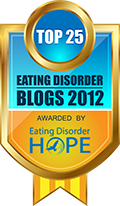More on EDs in midlife
Two new research studies out this week have delved more into the issue surrounding eating disorders in midlife (I've written on the subject before here).
One study looked at factors associated with disordered eating and body image dissatisfaction in middle aged women. It wasn't exceptionally mind-blowing research, but it did seem to uphold that many of the traits that put people at risk for EDs earlier in life still put people at higher risk later in life. What traits? Things like placing a high importance on appearance and function, poor self care, and lower cognitive reappraisal. These women also had higher BMIs than women without eating disorders.
The cognitive reappraisal in particular interested me, because this particular study looked at how these women were able to reframe changes in appearance due to aging. So rather than looking in the mirror at their gray hair and crow's feet and thinking "I'm an old hag," a woman could look at the same features and think of them of signs of a life well-lived. It strikes me that these difficulties echo difficulties with set-shifting that have been previously documented in people with eating disorders.
The other study looks at the 20-year outcome of both bulimia and EDNOS, beginning at an average age of 20 years, and ending at an average age of 40 years. Approximately three out of every four people who had BN at the beginning of the study had reached remission by the end of the study. Meaning, of course, that 25% of people with BN fail to significantly improve (though "remission" was not formally defined in the abstract). The authors said this:
Eating disorder point prevalence declined in women but not men from late adolescence to mid-life.Despite patterns of improvement in women, 4.5% reported a clinically significant eating disorder at mid-life, suggesting the need for more research on potential risk factors in this age group, such as pressures for women to maintain a youthful appearance.
And, I might add, research needs to focus on developing better treatments for BN and determining ways to help people stick with treatment.
It would be interesting to see how these numbers compared to rates of midlife EDs twenty years ago. Unfortunately, we don't really have this information. It seems that our culture's emphasis on beauty and youthfulness (or beauty as youthfulness) only helps perpetuate the factors that make people--especially women--vulnerable to EDs in the first place.






2 comments:
thanks for your posts! i, too, am a writer--creative nonfiction. i love your blog, and look forward to perusing future posts. i'm going to follow your blog.
check out my blog, life with cake!
gg
My EDNOS was late onset (I was 27 when it developed), so it's interesting to see studies about post-adolescent eating disorders. I'm not quite yet to what the study is considering "middle-aged," but I'm close enough to feel like they're talking about me. When I was in treatment, the age range of patients was a real eye opener. There were teenagers, and there were grandmothers.
In most of the other adults, their eating disorders had been in remission, and then they relapsed due to a triggering event (the death of a child, a major surgery, etc.) So I'm wondering about how scientists might best study eating disorders over the course of a lifetime, since they do so often have periods of relapse and remission. It's not as if the 75% of people with BN who were in remission at the 20-year mark of the second study had never had a relapse, or like the 25% of people who were currently struggling had never had periods of remission. We simply can't tell what happened in the intervening 20 years from statistics on where people are at the time of the study--at least it didn't seem like the statistics took that into consideration. I don't know how it would be best to measure rates of relapse and recovery, but I feel like it would be helpful to take some of the interim data into account. For most of us recovery isn't linear, and it can be hard to decide when a period remission truly begins. Then again, I may just be imagining how frustrated I will feel if the study in which I participated calls me when I'm 47, and I happen to have relapsed right around that time after years of having my symptoms under control.
Post a Comment